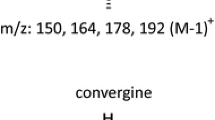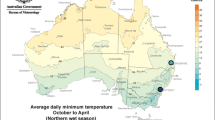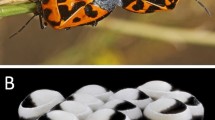Abstract
Theory predicts that warning signals should exhibit low variation to increase learning efficiency in predators. Many species, however, exhibit variation in warning colours within species and even within populations. An understudied example of within species variation is that between life stages, where animals change warning colouration throughout ontogeny. Understanding how warning signals change throughout life can help us identify the different ecological pressures that affect the evolution of warning signals. We used the Australasian cotton harlequin bug (Tectocoris diophthalmus) to explore how adults and nymphs differ in their defensive secretions and colouration. We performed spectrophotometric colour measurements and toxicity bioassays. Our results show, overall, no consistent association between colour and toxicity within species. There was no clear pattern for females and nymphs. Adult males, however, present the highest contrast against backgrounds, highest internal contrast, and highest toxicity. There was no association between colour and toxicity within males, nymphs or females. Our results suggest weak signal honesty in warning signals across life stages and sexes, and demonstrate that variation in colour within species is not necessarily linked to changes in toxicity.



Similar content being viewed by others
References
Abad R, Azhari S, Djozan D, Hejazi M (2012) Compounds in abdominal and metathoracic scent glands of nymphs and adults of Graphosoma lineatum (Linnaeus, 1758) (Het., scutelleridae) under laboratory conditions. Mun Entmol Zool 7:870–880
Amézquita A, Ramos Ó, González MC, Rodríguez C, Medina I, Simões PI, Lima AP (2017) Conspicuousness, color resemblance, and toxicity in geographically diverging mimicry: the pan-Amazonian frog Allobates femoralis. Evolution 71:1039–1050
Arenas LM, Walter D, Stevens M (2015) Signal honesty and predation risk among a closely related group of aposematic species. Sci Rep 5:11021
Aronsson M, Gamberale-Stille G (2008) Domestic chicks primarily attend to colour, not pattern, when learning an aposematic coloration. Anim Behav 75:417–423
Aronsson M, Gamberale-Stille G (2009) Importance of internal pattern contrast and contrast against the background in aposematic signals. Behav Ecol 20:1356–1362
Barnett JB, Scott-Samuel NE, Cuthill IC (2016) Aposematism: balancing salience and camouflage. Biol Lett 12:20160335
Bates D, Maechler M, Bolker B, Walker S (2014) lme4: linear mixed-effects models using Eigen and S4. R package version 1:1–23
Blount JD, Speed MP, Ruxton GD, Stephens PA (2008) Warning displays may function as honest signals of toxicity. Proc R Soc B Biol Sci 276:871–877
Booth CL (1990) Evolutionary significance of ontogenetic colour change in animals. Biol J Linn Soc 40:125–163
Briolat ES, Zagrobelny M, Olsen CE, Blount JD, Stevens M (2018) No evidence of quantitative signal honesty across species of aposematic burnet moths (Lepidoptera: Zygaenidae). J Evolut Biol 32:31–48
Briolat ES, Burdfield-Steel ER, Paul SC, Rönkä KH, Seymoure BM, Stankowich T, Stuckert AMM (2019) Diversity in warning coloration: selective paradox or the norm? Biol Rev 94:388–414
Chouteau M, Angers B (2011) The role of predators in maintaining the geographic organization of aposematic signals. Am Nat 178:810–817
Chouteau M, Arias M, Joron M (2016) Warning signals are under positive frequency-dependent selection in nature. Proc Natl Acad Sci USA 113:2164–2169
Čokl A (2008) Stink bug interaction with host plants during communication. J Insect Physiol 54:1113–1124
Cortesi F, Cheney K (2010) Conspicuousness is correlated with toxicity in marine opisthobranchs. J Evol Biol 23:1509–1518
de Jong PW, Holloway GJ, Brakefield PM, de Vos H (1991) Chemical defence in ladybird beetles (Coccinellidae). II. Amount of reflex fluid, the alkaloid adaline and individual variation in defence in 2-spot ladybirds (Adalia bipunctata). Chemoecology 2:15–19
Endler JA (1988) Frequency-dependent predation, crypsis and aposematic coloration. Philos Trans R Soc Lond B 319:505–523
English-Loeb GM, Collier BD (1987) Nonmigratory movement of adult harlequin bugs Murgantia histrionica (Hemiptera: Pentatomidae) as affected by sex, age and host plant quality. Am Midl Nat 118:189–197
Fabricant SA, Smith CL (2014) Is the hibiscus harlequin bug aposematic? The importance of testing multiple predators. Ecol Evol 4:113–120
Fabricant SA, Exnerová A, Ježová D, Štys P (2014) Scared by shiny? The value of iridescence in aposematic signalling of the hibiscus harlequin bug. Anim Behav 90:315–325
Fabricant SA, Burdfield-Steel ER, Umbers K, Lowe EC, Herberstein ME (2018) Warning signal plasticity in hibiscus harlequin bugs. Evol Ecol 32:489–507
Ferrari S, Cribari-Neto F (2004) Beta regression for modelling rates and proportions. J Appl Stat 31:799–815
Galarza JA, Nokelainen O, Ashrafi R, Hegna RH, Mappes J (2014) Temporal relationship between genetic and warning signal variation in the aposematic wood tiger moth (Parasemia plantaginis). Mol Ecol 23:4939–4957
Gelman A, Hill J (2006) Data analysis using regression and multilevel/hierarchical models. Cambridge University Press, Cambridge
Giffney RA, Kemp DJ (2014) Does it pay to care?: Exploring the costs and benefits of parental care in the Hibiscus Harlequin Bug Tectocoris diophthalmus (Heteroptera: Scutelleridae). Ethology 120:607–615
Grant JB (2007) Ontogenetic colour change and the evolution of aposematism: a case study in panic moth caterpillars. J Anim Ecol 76:439–447
Harmon SM, Mousseau TA (2007) Toxicity of the lovebug Plecia nearctica (Diptera: Bibionidae) in two common indicator organisms, Caenorhabditis elegans and Daphnia pulex. Entomol Generalis/J Gen Appl Entomol 32:311
Hartig F (2019) DHARMa: Residual Diagnostics for ## Hierarchical (Multi-Level / Mixed) Regression Models. R package ## version 0.2.6. http://florianhartig.github.io/DHARMa/
Hegna RH, Galarza JA, Mappes J (2015) Global phylogeography and geographical variation in warning coloration of the wood tiger moth (Parasemia plantaginis). J Biogeogr 42:1469–1481
Heinrich B (1993) How avian predators constrain caterpillar foraging. In: Stamp NE, Casey TM (eds) Caterpillars: ecological and evolutionary constraints of foraging. Chapman and Hall, New York, pp 224–247
Javahery M, Schaefer CW, Lattin JD (2000) Shield bugs (Scutelleridae). Heteroptera of economic importance. CRC Press, Boca Raton, pp 475–503
Joron M, Mallet JL (1998) Diversity in mimicry: paradox or paradigm? Trends Ecol Evol 13:461–466
Lee D-H, Leskey T (2015) Flight behavior of foraging and overwintering brown marmorated stink bug, Halyomorpha halys (Hemiptera: Pentatomidae). Bull Entomol Res 105:566–573
Lee TJ, Speed MP, Stephens PA (2011) Honest signaling and the uses of prey coloration. Am Nat 178:E1–E9
Lindstedt C, Schroderus E, Lindström L, Mappes T, Mappes J (2016) Evolutionary constraints of warning signals: a genetic trade-off between the efficacy of larval and adult warning coloration can maintain variation in signal expression. Evolution 70:2562–2572
Lindstedt C, Boncoraglio G, Cotter SC, Gilbert JDJ, Kilner RM (2019) Parental care shapes evolution of aposematism and provides lifelong protection against predators. bioRxiv, 644864
Lindström L, Alatalo RV, Lyytinen A, Mappes J (2001) Strong antiapostatic selection against novel rare aposematic prey. Proc Natl Acad Sci USA 98:9181–9184
Magnusson A, Skaug H, Nielsen A, Berg C, Kristensen K, Maechler M, van Bentham K, Bolker B, Brooks M, Brooks MM (2017) Package ‘glmmTMB’. R Package Version 02 0
Maia R, Eliason CM, Bitton PP, Doucet SM, Shawkey MD (2013) pavo: an R package for the analysis, visualization and organization of spectral data. Methods Ecol Evol 4:906–913
Mallet J, Gilbert LE Jr (1995) Why are there so many mimicry rings? Correlations between habitat, behaviour and mimicry in Heliconius butterflies. Biol J Linn Soc 55:159–180
Mallet J, Joron M (1999) Evolution of diversity in warning color and mimicry: polymorphisms, shifting balance, and speciation. Annu Rev Ecol Syst 30:201–233
McLain DK (1998) Non-genetic benefits of mate choice: fecundity enhancement and sexy sons. Anim Behav 55:1191–1201
Medina I, Wang IJ, Salazar C, Amézquita A (2013) Hybridization promotes color polymorphism in the aposematic harlequin poison frog, Oophaga histrionica. Ecol Evol 3:4388–4400
Mochida K, Kitada M, Ikeda K, Toda M, Takatani T, Arakawa O (2013) Spatial and temporal instability of local biotic community mediate a form of aposematic defense in newts, consisting of carotenoid-based coloration and tetrodotoxin. J Chem Ecol 39:1186–1192
Nokelainen O, Hegna RH, Reudler JH, Lindstedt C, Mappes J (2011) Trade-off between warning signal efficacy and mating success in the wood tiger moth. Proc R Soc B Biol Sci 279:257–265
Noonan BP, Comeault AA (2009) The role of predator selection on polymorphic aposematic poison frogs. Biol Lett 5:51–54
Poulton EB (1890) The colours of animals: their meaning and use, especially considered in the case of insects. D. Appleton, New York
Prudic KL, Noge K, Becerra JX (2008) Adults and nymphs do not smell the same: the different defensive compounds of the giant mesquite bug (Thasus neocalifornicus: Coreidae). J Chem Ecol 34:734
Rojas B, Endler JA (2013) Sexual dimorphism and intra-populational colour pattern variation in the aposematic frog Dendrobates tinctorius. Evol Ecol 27:739–753
Rönkä K, Mappes J, Michalis C, Kiviö R, Salokannas J, Rojas B (2018) Can multiple-model mimicry explain warning signal polymorphism in the wood tiger moth, Arctia plantaginis (Lepidoptera: Erebidae)? Biol J Linn Soc 124:237–260
Sanchez E, Pröhl H, Lüddecke T, Schulz S, Steinfartz S, Vences M (2019) The conspicuous postmetamorphic coloration of fire salamanders, but not their toxicity, is affected by larval background albedo. J Exp Zool Part B Mol Dev Evolut 332:26–35
Song S, Kim S, Kwon SW, Lee S-I, Jablonski PG (2018) Defense sequestration associated with narrowing of diet and ontogenetic change to aposematic colours in the spotted lanternfly. Sci Rep 8:16831
Speed MP, Ruxton GD, Blount JD, Stephens PA (2010) Diversification of honest signals in a predator–prey system. Ecol Lett 13:744–753
Staddon B, Thorne M, Knight D (1987) The scent glands and their chemicals in the aposematic cotton harlequin bug, Tectocoris-Diophthalmus (Heteroptera, Scutelleridae). Aust J Zool 35:227–234
Stevens M, Ruxton GD (2012) Linking the evolution and form of warning coloration in nature. Proc R Soc B 279:417–426
Stuckert AM, Venegas PJ, Summers K (2014) Experimental evidence for predator learning and Müllerian mimicry in Peruvian poison frogs (Ranitomeya, Dendrobatidae). Evol Ecol 28:413–426
Stuckert AM, Saporito RA, Summers K (2018) An empirical test indicates only qualitatively honest aposematic signaling within a population of vertebrates. J Herpetol 52:201–208
Summers K, Clough ME (2001) The evolution of coloration and toxicity in the poison frog family (Dendrobatidae). Proc Natl Acad Sci USA 98:6227–6232
Summers K, Speed M, Blount J, Stuckert A (2015) Are aposematic signals honest? A review. J Evol Biol 28:1583–1599
Sword GA (1999) Density-dependent warning coloration. Nature 397:217
Twomey E, Vestergaard JS, Summers K (2014) Reproductive isolation related to mimetic divergence in the poison frog Ranitomeya imitator. Nat Commun 5:4749
Wang IJ, Shaffer HB (2008) Rapid color evolution in an aposematic species: a phylogenetic analysis of color variation in the strikingly polymorphic strawberry poison-dart frog. Evol Int J Org Evol 62:2742–2759
Wink M, Grimm C, Koschmieder C, Sporer F, Bergeot O (2000) Sequestration of phorbolesters by the aposematically coloured bug Pachycoris klugii (Heteroptera: Scutelleridae) feeding on Jatropha curcas (Euphorbiaceae). Chemoecology 10:179–184
Winters AE, Stevens M, Mitchell C, Blomberg SP, Blount JD (2014) Maternal effects and warning signal honesty in eggs and offspring of an aposematic ladybird beetle. Funct Ecol 28:1187–1196
Acknowledgements
We would like to thank University of Melbourne for funding awarded to I.M. and the British Ecological Society for funding awarded to I.M and M.L.H. We would also like to thank Constanza León, Daniela Perez, Lina María Arenas, Devi Stuart-Fox, Scott Fabricant, Emily Burdfield-Steel, Phillip Lincoln Erm and Ben Phillips for help with information on the bug, advice on experimental design, access to Daphnia, and help with toxicity assays.
Author information
Authors and Affiliations
Corresponding author
Ethics declarations
Conflict of interest
The authors declare that they have no conflict of interest.
Additional information
Publisher's Note
Springer Nature remains neutral with regard to jurisdictional claims in published maps and institutional affiliations.
Electronic supplementary material
Below is the link to the electronic supplementary material.
Rights and permissions
About this article
Cite this article
Medina, I., Wallenius, T. & Head, M. No honesty in warning signals across life stages in an aposematic bug. Evol Ecol 34, 59–72 (2020). https://doi.org/10.1007/s10682-019-10025-0
Received:
Accepted:
Published:
Issue Date:
DOI: https://doi.org/10.1007/s10682-019-10025-0




